
3507
.pdf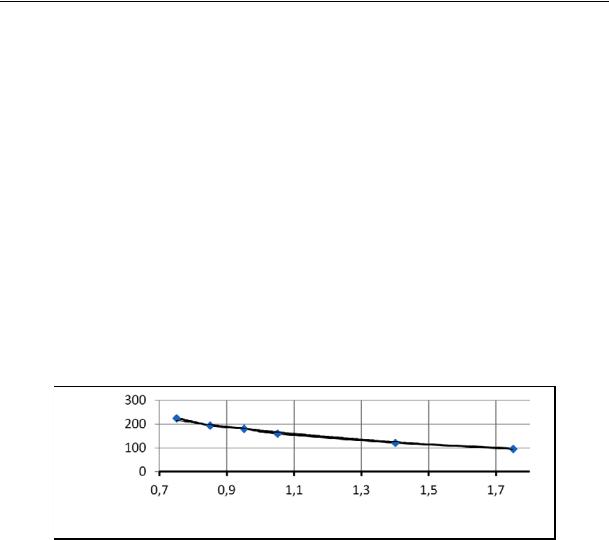
Russian Journal of Building Construction and Architecture
load on the busiest lane by road categories is governed by a linear relationship and has a common pattern for all the regulatory documents.
As the number of applications of the estimated load increases, the requirements for the minimum required modulus of elasticity of the pavement change, which characterizes the capacity of a pavement to resist developing residual deformations under the effect of transport load. When vehicles move under an axial load in the tire-surfacing contact zone, an elastic deflection of a roadway surfacing occurs depending on the strength of a road structure. In order to ensure the specified service life of a pavement, it is necessary that the resulting deformation under the action of the load is not over the maximum permissible deflection of a pavement.
The studies [1, 8, 9, 14, 15] established the relationship between the minimum required modulus of elasticity of pavement and maximum elastic deflection of a pavement (Fig. 2).
Modulus of long-term elasticity, MPa
Elastic deflection, mm
Fig. 2. Dependence of the modulus of long-term elasticity of asphalt concrete pavement on the elastic deflection limit
The dependence characterizes the relationship between the modulus of long-term elasticity of a non-rigid surfacing and the elastic deflection limit at the traffic intensity of 103 cars/day with the load to an estimated car of 10 kN.
The numerical value of the modulus of long-term elasticity of an asphalt concrete surfacing depending on the elastic deflection can be identified as follows:
Еу 399.2 е 0.824 упр , МPа, |
(3) |
where λупр is the elastic deflection of a surfacing, mm. The correlation coefficient is 0.99.
According to the experimental studies [1, 14], the dependence between the elastic deflection limit of a roadway surfacing and traffic intensity was found (Fig. 3).
70
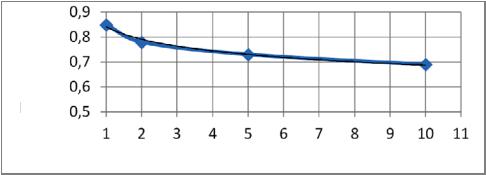
Issue № 1 (45), 2020 |
ISSN 2542-0526 |
The estimated elastic deflection limit of a roadway surfacing takes the following form depending on the traffic intensity:
упр 0.84N 0.88, mm, |
(4) |
where Ν is the traffic intensity, 103 cars/day. The correlation coefficient of the dependence is 0.98.
Deflection limit, mm
Traffic intensity, 103 cars/day
Fig. 3. Dependence of the elastic deflection limit of a roadway surfacing to the traffic intensity of up to 103 cars/day with the specified load of 10 kN to an estimated car
Considering the identified dependencies of the minimum elastic modulus, the maximum elastic deflection of a roadway surfacing and the number of load applications according to the normative documents Industrial Road Guidelines (ОДН) 218.046-01, International Industrial Road Guidelines (МОДН) 2-2001, an empirical dependence was adopted that determines the minimum modulus of elasticity of a roadway surfacing depending on the number of load applications at an estimated specific wheel pressure p on the road surface ranging from 0.5 to 0.6 MPa that takes the following form:
Еmin 98.65 [lg N р c], МPа, |
(5) |
where Nр is the total estimated number of load applications over a life cycle of a roadway surfacing; с is the empirical parameter that for the estimated axial load of 100 kN equals 3.55 of 110 kN — 3.25; of 130 kN — 3.05.
The strength characteristics of the pavement depend on the ultimate loads on the axis of the calculated biaxial vehicle. In the normative documents of Industrial Road Guidelines (ОДН) 218.046-01 and International Industrial Road Guidelines (МОДН) 2-2001 the estimated load on a pavement is presented in the form of a group of a calculated load (A1, A2, A3) corresponding to the normative static load on the axle of the car of 100, 110 and 130 kN with the
71
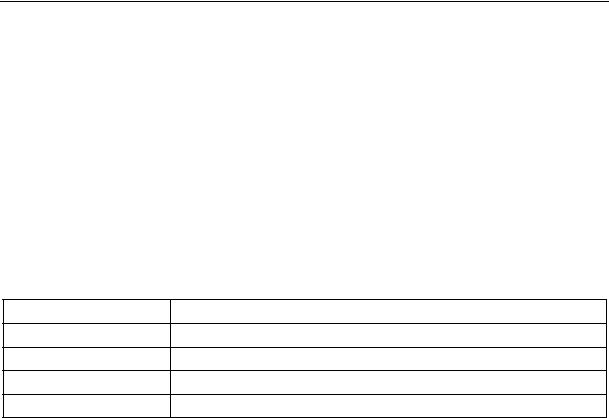
Russian Journal of Building Construction and Architecture
calculated parameter of the mobile load on a pavement which equals the specific pressure wheels on a road surface (air pressure in the tires) p = 0.6 MPa.
Depending on the total minimum estimated number of applications of the calculated load on the busiest lane and road categories, the normative documents Industrial Road Guidelines (ОДН) 218.046-01 and International Industrial Road Guidelines (МОДН) 2-2001 determine the required minimum elastic modulus that do not take into account the design load group A (Table 2).
Table 2
Minimum value of the required elasticity modulus of a roadway surfacing on the busiest lane
Road category |
Required elasticity modulus of a roadway surfacing, МPа |
I |
230 |
II |
220 |
III |
200 |
IV |
150 |
According to dependence (5), the calculation results of the minimum required modulus of elasticity of a pavement showed that the suggested minimum required modulus of elasticity of a pavement is provided at the load of A1. As a load group increases, so does the minimum required modulus of elasticity of a pavement.
The dependence of the minimum required modulus of elasticity of pavement on the technical category of the road and an estimated load group is presented in the technical code of the established practice in the Republic of Belarus Technical Code of Practice (TKП) 45-3.03-112- 2008 (02250) “Highways. Rigid Pavement. Design Guidelines” (Table 3).
Increasing the load-carrying capacity of vehicles causes a change in the design parameters of car tires, which allows pressure in the tire and thus a pavement load to increase. Simultaneously, the normative documents Set of Guidelines (СП) 34.13330.2012, GOST (ГОСТ) 32960-2014 and Preliminary National Standards (ПНСТ) 265-2018, the design load group for a major surfacing is accepted A-11.5 with an axial load of 115 kN with an estimated load on a road surface (tire pressure) of 0.8 MPa, and for lightweight surfacing, an estimated load group is A-10 with an axle load of 100 kN. In Industrial Road Guidelines (ОДН) 218.046-01, International Industrial Road Guidelines (МОДН) 2-2001, the air pressure in the tires equals 0.6 MPa regardless of the estimated load group and pavement type, in addition, the estimated load group A2 corresponds to the axle load of 110 kN.
72

Issue № 1 (45), 2020 |
ISSN 2542-0526 |
Table 3
Required elasticity modulus of a roadway surfacing depending on a road category and load group, MPa
|
Required elasticity modulus of a roadway surfacing Етр, МPа |
|||
Highway category |
|
for a major type for load groups |
|
|
|
|
|
|
А3 |
|
А1 |
|
А2 |
|
|
|
|
|
310 |
I |
230 |
|
270 |
|
|
|
|
|
280 |
II |
220 |
|
250 |
|
|
|
|
|
260 |
III |
200 |
|
230 |
|
|
|
|
|
220 |
IV |
180 |
|
200 |
|
|
|
|
|
|
For major types of surfacing where the pressure is other than 0.6 MPa, the normative document Preliminary National Standards (ПНСТ) 265-2018 while calculating the minimum required modulus of elasticity sets forth a relationship that considers an increase in an estimated load using the formula:
Е |
|
p |
98.65[lg N |
р |
с], МPа, |
(6) |
|
||||||
min |
|
0.6 |
|
|
|
|
|
|
|
|
|
|
where р is an estimated surfacing pressure; Nр is the total number of load application on the lane over a normative period in between major repairs, empirical parameter that for an estimated load is А-10 — 3.55; А-11.5 — 3.20.
An increase in pressure in the tire-surfacing contact zone from 0.6 to 0.8 MPa as well as that in the total minimum estimated number of applications of an estimated load on the busiest lane requires an increase in the minimum required modulus of elasticity of a pavement, which is accounted for in Preliminary National Standards (ПНСТ) 265-2018 (Table 4).
Table 4
Required elasticity modulus of a non-rigid roadway surfacing
|
Minimum required elasticity modulus of a roadway surfacing, MPa, |
||||
Road category |
|
depending on the type of a roadway surfacing |
|
||
|
|
|
|
|
|
|
Major |
|
Lightweight |
|
Transitional |
|
|
|
|
|
|
I |
330 |
|
— |
|
— |
|
|
|
|
|
|
II |
325 |
|
— |
|
— |
|
|
|
|
|
|
III |
310 |
|
235 |
|
— |
|
|
|
|
|
|
IV |
250 |
|
180 |
|
110 |
|
|
|
|
|
|
V |
— |
|
150 |
|
75 |
|
|
|
|
|
|
73

Russian Journal of Building Construction and Architecture
Based on the analysis of the normative documentation on calculating non-rigid pavement according to permissible elastic deflection, it was found that in modern conditions of operation of roads, considering an increase in traffic intensity of vehicles and in axial load on pavements, the regulatory framework for calculating the strength characteristics of pavements non-rigid type had to be revised according to permissible elastic deflection which is reflected in the regulatory document Preliminary National Standards (ПНСТ) 265-2018. However, this document does not account for the axle load of 130 kN which is typical of heavy-duty vehicles.
2. Determining the parameters of a traffic flow. In order to clarify the load on the road surface during movement of a traffic flow with high intensity and significant axial load in natural conditions, experimental studies were performed in order to identify the effect of a traffic flow on the strength characteristics of road pavement.
The studies were conducted on a federal highway of the technical category II with a non-rigid surfacing in a traffic flow in summer. The results of measuring the traffic intensity of vehicles with varying axial loads on the investigated section of a road showed that the daily reduced traffic intensity is about 20.000 cars/day. Vehicles moving along a specified section of the road and parameters of the tire-surfacing contact for this group of cars and automatic trains (4––6 m long lightweight cars, 6––9 m long small trucks, 9––13 m heavy-duty trucks) are shown in Table 5.
Таble 5
Parameters of the tire-surfacing contact
Car make |
Tire brand |
Load, kN |
Air pressure |
Diameter |
|
in the tire, MPa |
of the wheel print, сm |
||||
|
|
|
|||
|
|
|
|
|
|
DAF XF 95 |
385/65R22.5 |
44.15 |
0.90 |
25.00 |
|
|
|
|
|
|
|
SCHMITZ |
295/80R22.5 |
32.86 |
0.85 |
22.19 |
|
CARGOBUL |
|||||
|
|
|
|
||
|
|
|
|
|
|
KamАZ |
10.00R20 |
29.43 |
0.80 |
21.65 |
|
|
|
|
|
|
|
Gazel |
185/80R16C |
8.58 |
0.44 |
15.7 |
|
|
|
|
|
|
|
Chevrolet Niva |
205/75R15 |
5.05 |
0.21 |
17.5 |
|
|
|
|
|
|
The analysis of a traffic flow on an effect of axial load on a road surface showed that the proportion of freight transport over the estimated load on a road pavement is from 30 to 40 % of the total number of vehicles. According to Table 5, the transmitted load on a road surface varies over a wide interval depending on the axial load of the car.
74
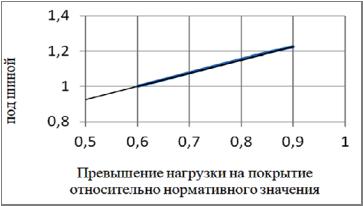
Issue № 1 (45), 2020 |
ISSN 2542-0526 |
The analysis of the design parameters of pneumatic tires for vehicles showed that they range considerably. In compliance with the GOST R (ГОСТ Р) 52899-2007, operating modes (load and pressure) are normalized for each tire brand. It was established that the contact area of the pneumatic tire as well as the stress distribution in the tire-surfacing contact zone depends not only on the load and internal pressure in the tire but also on its design parameters. Depending on the load-carrying capacity and structural design of a car, the effect of a traffic flow on the road structure differs. An increase in the standard pressure in the tire-surfacing contact zone is commonly typical of heavy-duty vehicles, which is accounted for by an increase in the axial standard load and the division into estimated load groups.
The normative documents GOST (ГОСТ) 32960 and Preliminary National Standards (ПНСТ) 265-2018 consider the estimated load on the road surface of 0.8 MPa. According to Table 5, presently in a traffic flow, the load on the road surface is over the recommended value and can get as high as 0.9 MPa. Assuming that the estimated load on the surfacing at 0.6 MPa per unit (according to Industrial Road Guidelines (ОДН) 218.046-01), Fig. 4 shows the dependence of the coefficient of an excess load under the tire from the current load of the vehicle.
The numerical value of the coefficient of an excess load under the tire from the current load can be given by the following dependence:
|
|
|
Кп(p)=0.75р+0.549, |
(7) |
|
where р is the estimated specific pressure under the tire (0.6 МPа). |
|
||||
The correlation coefficient is 0.99. |
|
||||
|
|
|
|||
|
Coefficient of an excess load under the tire |
|
|
||
|
|
|
|
|
|
|
|
|
Excess load on the surfacing in relation |
|
|
|
|
|
|
|
|
|
|
|
to the normative value |
|
|
|
|
|
|
|
|
Fig. 4. Dependence of the coefficient of an excess load under the tire on the current transport load |
|
||||
Then the dependence (6) can take the following form: |
|
||||
|
|
|
Еmin =98.65Kп(p)[lgSN р -с], МPа. |
(8) |
|
75
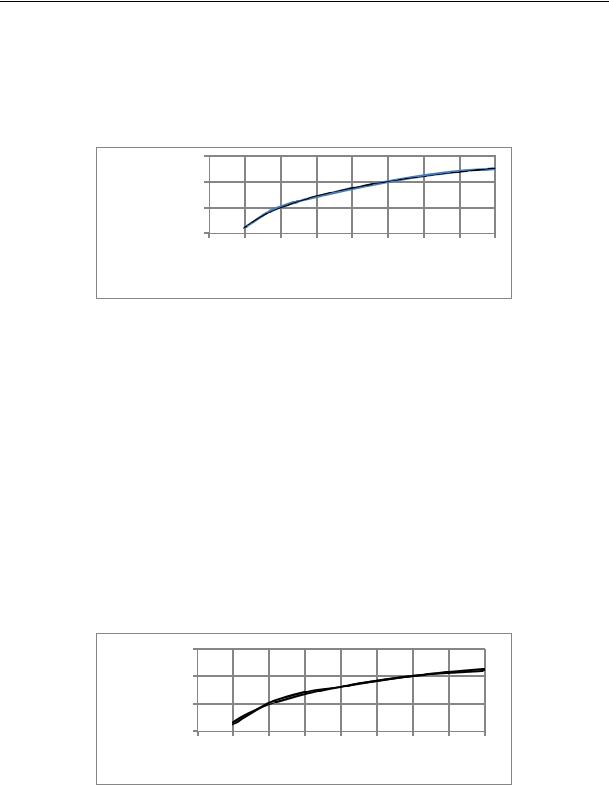
Russian Journal of Building Construction and Architecture
In order to clarify the effect of traffic intensity on the minimum modulus of elasticity, we use the dependence (5) considering the predicted traffic intensity of up to 40.000 cars/day with the estimated load on pavement of 10 kN. The calculation results are presented as the dependence in Fig. 5.
Minimum elasticity modulus
Traffic intensity, 103 cars/day
Fig. 5. Dependence of a minimum elasticity modulus on the traffic intensity
The numerical value of a minimum elasticity modulus depending on the traffic intensity can be as follows:
Еmin =11.02ln N +204.35, МPа, |
(9) |
where Ν is the traffic intensity, 103 cars/day. The correlation coefficient of the dependence is 0.99.
Let us present the data in Fig. 5 in relative values assuming that the traffic intensity at 103 cars/day per unit, let us denote the accepted value by the coefficient of the effect of the traffic intensity KN of vehicles on the minimum modulus of elasticity of a pavement. Figure 6 shows the dependence of the coefficient KN on the traffic intensity of up to 40.000 cars/day.
КCoefficient N
Traffic intensity, 103 cars/day
Fig. 6. Coefficient КN on the traffic intensity, 103 cars/day |
|
The numerical value of the coefficient is given by the following dependence: |
|
КN =0.0474lnN +0.88, |
(10) |
where N is the traffic intensity, 103 cars/day. The correlation coefficient of the dependence is 0.99.
76
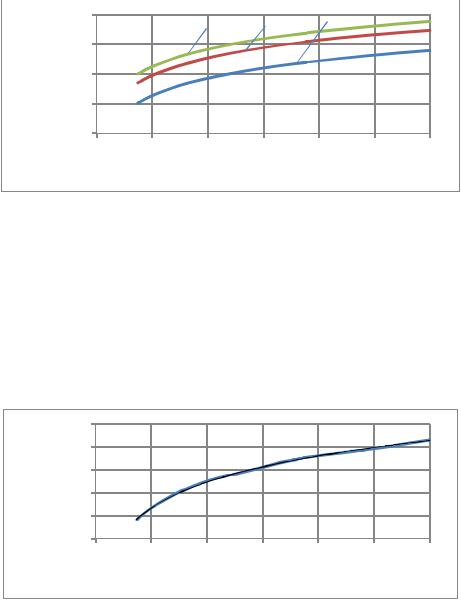
Issue № 1 (45), 2020 |
ISSN 2542-0526 |
In the normative documents while calculating the strength of pavement, the traffic intensity of vehicles is expressed by the total minimum estimated number of applications of the estimated load on the busiest lane.
Unlike Industrial Road Guidelines (ОДН) 218.046-01, International Industrial Road Guidelines (МОДН) 2-2001 where the number of applications of the reduced design load on pavement is 750.000, in the document Preliminary National Standards (ПНСТ) 265-2018, the number of applications of the reduced design load is 1.285.000. Considering the dependence (5), Fig. 7 shows the dependence of the minimum elastic modulus on the traffic intensity of up to 30.000.000 applications of the reduced design load to the pavement considering the load group at the design pressure of the surfacing of 0.6 MPa.
Minimum elasticity modulus, MPa
3 2 1
Number of applications of the estimated load, 103
Fig. 7. Dependence of the minimum elasticity modulus on the number of the specified load applications: 1 — А1; 2 — А2; 3 — А3
In order to identify the general regularity of the dependence of the minimum elastic modulus on the number of applications of the reduced estimated load, the estimated values are presented in Fig. 7 in relative values assuming the minimal elastic moduli at 750.000 applications of reduced load for different load groups per unit. This value is denoted by means of the coefficient of effect of the number of applications of the reduced load.
Coefficient of an effect of the number of applications of the specified load
Number of the load applications, 103
Fig. 8. Dependence of the coefficient of an effect on the number of applications of the estimated load
77
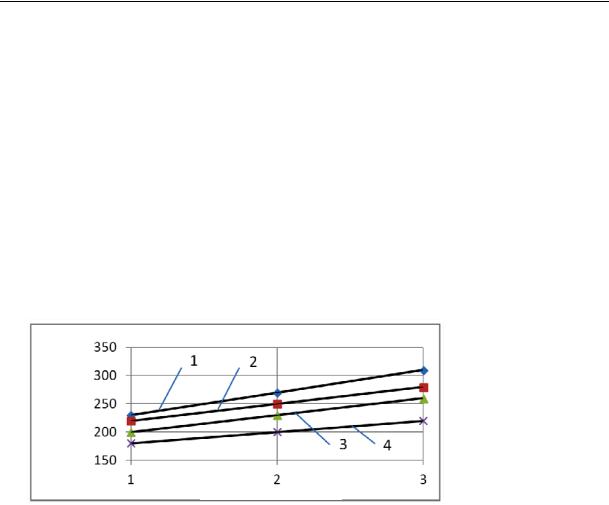
Russian Journal of Building Construction and Architecture
Fig. 8 shows the dependence of the coefficient of an effect on the number of applications of the reduced estimated load.
The numerical value of the coefficient of an effect on the number of applications of the reduced estimated load can be given by the following dependence:
КN =0.165ln N -0.0978, |
(11) |
where N is the number of applications of the reduced load. The correlation coefficient of the dependence is 0.99.
According to the Technical Code of Practice (TKП) 45-3.03-112-2008 (Table 3), the required modulus of elasticity depends on the load group. Fig. 9 shows the dependences of the effect of the load group on the required modulus of elasticity for different road categories.
MPa
Elasticity modulus,
1 is Category I;
2 is Category II;
3 is Category III;
4 is Category IV
Load group, A
Fig. 9. Dependence of the required elasticity model on the load group for different road categories
According to Fig. 9, the elastic modulus of the pavement depends on a load group and is governed by a directly proportional relationship. The analysis of the above dependencies for identifying a minimum required elastic modulus of a load group showed that regardless of the category of road, they are described by means of a linear dependence.
In order to determine the general dependence of the required elastic modulus on a load group, the data in Fig. 9 is presented in relative values considering the elasticity for load group A1 per unit. Let us denote the accepted value by the coefficient of influence of the load group on the elastic modulus Кгн. Fig. 10 shows the dependence of the elastic modulus on a load group. The numerical value of the coefficient of an effect of a load group Кгн on a roadway surfacing is given by the following dependencies:
–– according to the Industrial Road Guidelines (ОДН) 218.046-01:
Кгн 0.1735А 0.8267, |
(12) |
the correlation coefficient of the dependence is 1.0;
78
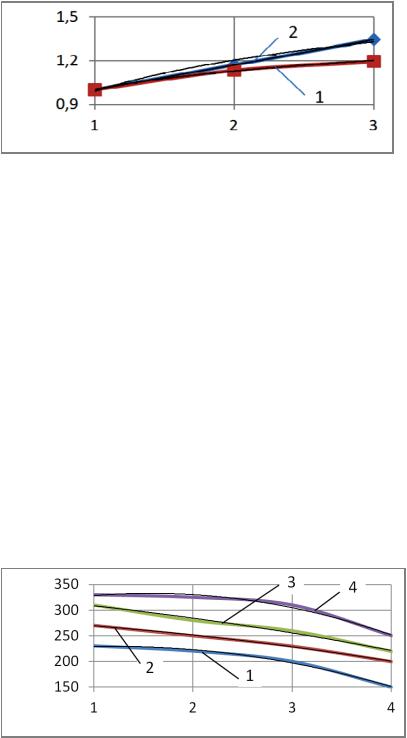
Issue № 1 (45), 2020 |
ISSN 2542-0526 |
–– Preliminary National Standards (ПНСТ) 265-2018:
Кгн =0.1805ln А+1.0032, |
(13) |
where А is a load group. The correlation coefficient of the dependence is 0.99.
Coefficient, Кгн
|
1 is according to the Industrial Road |
|
|
Guidelines (ОДН) 218.046-01; |
|
|
2 is according to the Preliminary |
|
|
National Standards (ПНСТ) |
|
|
265-2018 |
|
Load group, A |
||
|
Fig. 10. Dependence of the coefficient of an effect of a load group Кгн on a roadway surfacing on a load group А
Then a minimum required elasticity modulus of a road structure depending on a load group can be given by the following dependencies:
–– according to the Industrial Road Guidelines (ОДН) 218.046-01:
Еупр = 230Кгн; |
(14) |
–– Preliminary National Standards (ПНСТ) 265-2018: |
|
Еупр =330Кгн. |
(15) |
Thus the resulting dependencies allow the required minimum elasticity modulus of a surfa-cing to be identified depending on a load group according to the normative documents Industrial Road Guidelines (ОДН) 218.046-01 and Preliminary National Standards (ПНСТ) 265-2018.
3. Effect of structural parameters of pavement on its strength characteristics. Fig. 11 shows the dependences of the required modulus of elasticity of a pavement on a road category with a traffic intensity of less than 40.000 cars/day.
MPa
Elasticity modulus,
1 is А3;
2 is А2;
3 is А1;
4 is according to the Preliminary National Standards
(ПНСТ) 265-2018
Road category
Fig. 11. Dependence of the elasticity modulus of a road structure on a road category for different groups of an estimated load
79
